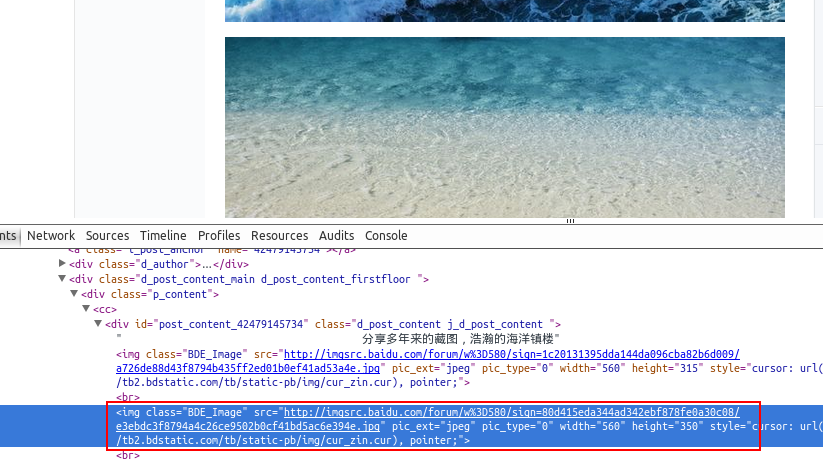简单实现python爬虫功能
在我们日常上网浏览网页的时候,经常会看到一些好看的图片,我们就希望把这些图片保存下载,或者用户用来做桌面壁纸,或者用来做设计的素材。
我们最常规的做法就是通过鼠标右键,选择另存为。但有些图片鼠标右键的时候并没有另存为选项,还有办法就通过就是通过截图工具截取下来,但这样就降低图片的清晰度。好吧~!其实你很厉害的,右键查看页面源代码。
我们可以通过python 来实现这样一个简单的爬虫功能,把我们想要的代码爬取到本地。下面就看看如何使用python来实现这样一个功能。
一、获取整个页面数据
首先我们可以先获取要下载图片的整个页面信息。
getjpg.py
#coding=utf-8
import urllib
def getHtml(url):
page = urllib.urlopen(url)
html = page.read()
return html
html = getHtml("http://tieba.baidu.com/p/2738151262")
print html
Urllib模块提供了读取web页面数据的接口,我们可以像读取本地文件一样读取www和ftp上的数据。首先,我们定义了一个getHtml()函数:
urllib.urlopen()方法用于打开一个URL地址。
read()方法用于读取URL上的数据,向getHtml()函数传递一个网址,并把整个页面下载下来。执行程序就会把整个网页打印输出。
二、筛选页面中想要的数据
Python 提供了非常强大的正则表达式,我们需要先要了解一点python 正则表达式的知识才行。
假如我们百度贴吧找到了几张漂亮的壁纸,通过到前段查看工具。找到了图片的地址,如:src=”http://imgsrc.baidu.com/forum......jpg”pic_ext=”jpeg”

修改代码如下:
import re
import urllib
def getHtml(url):
page = urllib.urlopen(url)
html = page.read()
return html
def getImg(html):
reg = r'src="(.+?\.jpg)" pic_ext'
imgre = re.compile(reg)
imglist = re.findall(imgre,html)
return imglist
html = getHtml("http://tieba.baidu.com/p/2460150866")
print getImg(html)
我们又创建了getImg()函数,用于在获取的整个页面中筛选需要的图片连接。re模块主要包含了正则表达式:
- re.compile() 可以把正则表达式编译成一个正则表达式对象.
- re.findall() 方法读取html 中包含 imgre(正则表达式)的数据.
运行脚本将得到整个页面中包含图片的URL地址。
三、将页面筛选的数据保存到本地
把筛选的图片地址通过for循环遍历并保存到本地,代码如下:
#coding=utf-8
import urllib
import re
def getHtml(url):
page = urllib.urlopen(url)
html = page.read()
return html
def getImg(html):
reg = r'src="(.+?\.jpg)" pic_ext'
imgre = re.compile(reg)
imglist = re.findall(imgre,html)
x = 0
for imgurl in imglist:
urllib.urlretrieve(imgurl,'%s.jpg' % x)
x+=1
html = getHtml("http://tieba.baidu.com/p/2460150866")
print getImg(html)
这里的核心是用到了urllib.urlretrieve()方法,直接将远程数据下载到本地。
通过一个for循环对获取的图片连接进行遍历,为了使图片的文件名看上去更规范,对其进行重命名,命名规则通过x变量加1。保存的位置默认为程序的存放目录。
程序运行完成,将在目录下看到下载到本地的文件。
结果展示:

以上就是本文的全部内容,希望对大家实现Python爬虫功能有所帮助。

Hot AI Tools

Undresser.AI Undress
AI-powered app for creating realistic nude photos

AI Clothes Remover
Online AI tool for removing clothes from photos.

Undress AI Tool
Undress images for free

Clothoff.io
AI clothes remover

AI Hentai Generator
Generate AI Hentai for free.

Hot Article

Hot Tools

Notepad++7.3.1
Easy-to-use and free code editor

SublimeText3 Chinese version
Chinese version, very easy to use

Zend Studio 13.0.1
Powerful PHP integrated development environment

Dreamweaver CS6
Visual web development tools

SublimeText3 Mac version
God-level code editing software (SublimeText3)

Hot Topics
 1377
1377
 52
52
 Do mysql need to pay
Apr 08, 2025 pm 05:36 PM
Do mysql need to pay
Apr 08, 2025 pm 05:36 PM
MySQL has a free community version and a paid enterprise version. The community version can be used and modified for free, but the support is limited and is suitable for applications with low stability requirements and strong technical capabilities. The Enterprise Edition provides comprehensive commercial support for applications that require a stable, reliable, high-performance database and willing to pay for support. Factors considered when choosing a version include application criticality, budgeting, and technical skills. There is no perfect option, only the most suitable option, and you need to choose carefully according to the specific situation.
 How to use mysql after installation
Apr 08, 2025 am 11:48 AM
How to use mysql after installation
Apr 08, 2025 am 11:48 AM
The article introduces the operation of MySQL database. First, you need to install a MySQL client, such as MySQLWorkbench or command line client. 1. Use the mysql-uroot-p command to connect to the server and log in with the root account password; 2. Use CREATEDATABASE to create a database, and USE select a database; 3. Use CREATETABLE to create a table, define fields and data types; 4. Use INSERTINTO to insert data, query data, update data by UPDATE, and delete data by DELETE. Only by mastering these steps, learning to deal with common problems and optimizing database performance can you use MySQL efficiently.
 MySQL can't be installed after downloading
Apr 08, 2025 am 11:24 AM
MySQL can't be installed after downloading
Apr 08, 2025 am 11:24 AM
The main reasons for MySQL installation failure are: 1. Permission issues, you need to run as an administrator or use the sudo command; 2. Dependencies are missing, and you need to install relevant development packages; 3. Port conflicts, you need to close the program that occupies port 3306 or modify the configuration file; 4. The installation package is corrupt, you need to download and verify the integrity; 5. The environment variable is incorrectly configured, and the environment variables must be correctly configured according to the operating system. Solve these problems and carefully check each step to successfully install MySQL.
 MySQL download file is damaged and cannot be installed. Repair solution
Apr 08, 2025 am 11:21 AM
MySQL download file is damaged and cannot be installed. Repair solution
Apr 08, 2025 am 11:21 AM
MySQL download file is corrupt, what should I do? Alas, if you download MySQL, you can encounter file corruption. It’s really not easy these days! This article will talk about how to solve this problem so that everyone can avoid detours. After reading it, you can not only repair the damaged MySQL installation package, but also have a deeper understanding of the download and installation process to avoid getting stuck in the future. Let’s first talk about why downloading files is damaged. There are many reasons for this. Network problems are the culprit. Interruption in the download process and instability in the network may lead to file corruption. There is also the problem with the download source itself. The server file itself is broken, and of course it is also broken when you download it. In addition, excessive "passionate" scanning of some antivirus software may also cause file corruption. Diagnostic problem: Determine if the file is really corrupt
 Does mysql need the internet
Apr 08, 2025 pm 02:18 PM
Does mysql need the internet
Apr 08, 2025 pm 02:18 PM
MySQL can run without network connections for basic data storage and management. However, network connection is required for interaction with other systems, remote access, or using advanced features such as replication and clustering. Additionally, security measures (such as firewalls), performance optimization (choose the right network connection), and data backup are critical to connecting to the Internet.
 How to optimize database performance after mysql installation
Apr 08, 2025 am 11:36 AM
How to optimize database performance after mysql installation
Apr 08, 2025 am 11:36 AM
MySQL performance optimization needs to start from three aspects: installation configuration, indexing and query optimization, monitoring and tuning. 1. After installation, you need to adjust the my.cnf file according to the server configuration, such as the innodb_buffer_pool_size parameter, and close query_cache_size; 2. Create a suitable index to avoid excessive indexes, and optimize query statements, such as using the EXPLAIN command to analyze the execution plan; 3. Use MySQL's own monitoring tool (SHOWPROCESSLIST, SHOWSTATUS) to monitor the database health, and regularly back up and organize the database. Only by continuously optimizing these steps can the performance of MySQL database be improved.
 How to optimize MySQL performance for high-load applications?
Apr 08, 2025 pm 06:03 PM
How to optimize MySQL performance for high-load applications?
Apr 08, 2025 pm 06:03 PM
MySQL database performance optimization guide In resource-intensive applications, MySQL database plays a crucial role and is responsible for managing massive transactions. However, as the scale of application expands, database performance bottlenecks often become a constraint. This article will explore a series of effective MySQL performance optimization strategies to ensure that your application remains efficient and responsive under high loads. We will combine actual cases to explain in-depth key technologies such as indexing, query optimization, database design and caching. 1. Database architecture design and optimized database architecture is the cornerstone of MySQL performance optimization. Here are some core principles: Selecting the right data type and selecting the smallest data type that meets the needs can not only save storage space, but also improve data processing speed.
 Solutions to the service that cannot be started after MySQL installation
Apr 08, 2025 am 11:18 AM
Solutions to the service that cannot be started after MySQL installation
Apr 08, 2025 am 11:18 AM
MySQL refused to start? Don’t panic, let’s check it out! Many friends found that the service could not be started after installing MySQL, and they were so anxious! Don’t worry, this article will take you to deal with it calmly and find out the mastermind behind it! After reading it, you can not only solve this problem, but also improve your understanding of MySQL services and your ideas for troubleshooting problems, and become a more powerful database administrator! The MySQL service failed to start, and there are many reasons, ranging from simple configuration errors to complex system problems. Let’s start with the most common aspects. Basic knowledge: A brief description of the service startup process MySQL service startup. Simply put, the operating system loads MySQL-related files and then starts the MySQL daemon. This involves configuration




